Evaluating Cultural Dimensions and Global Leadership in Organizations
VerifiedAdded on 2023/06/04
|11
|1363
|425
Report
AI Summary
This report provides an analysis of cultural dimensions and global leadership behaviors. It identifies and summarizes nine critical dimensions of culture as defined by House et al., along with describing six global leadership behaviors. The report also evaluates the strengths and weaknesses of different global leadership styles, emphasizing the importance of understanding cultural biases and adapting leadership approaches to diverse cultural settings. It concludes that culture is a diverse concept that varies from country to country and highlights the significance for leaders to effectively communicate and lead employees from different cultural backgrounds. Desklib offers a platform where students can access similar solved assignments and study tools.
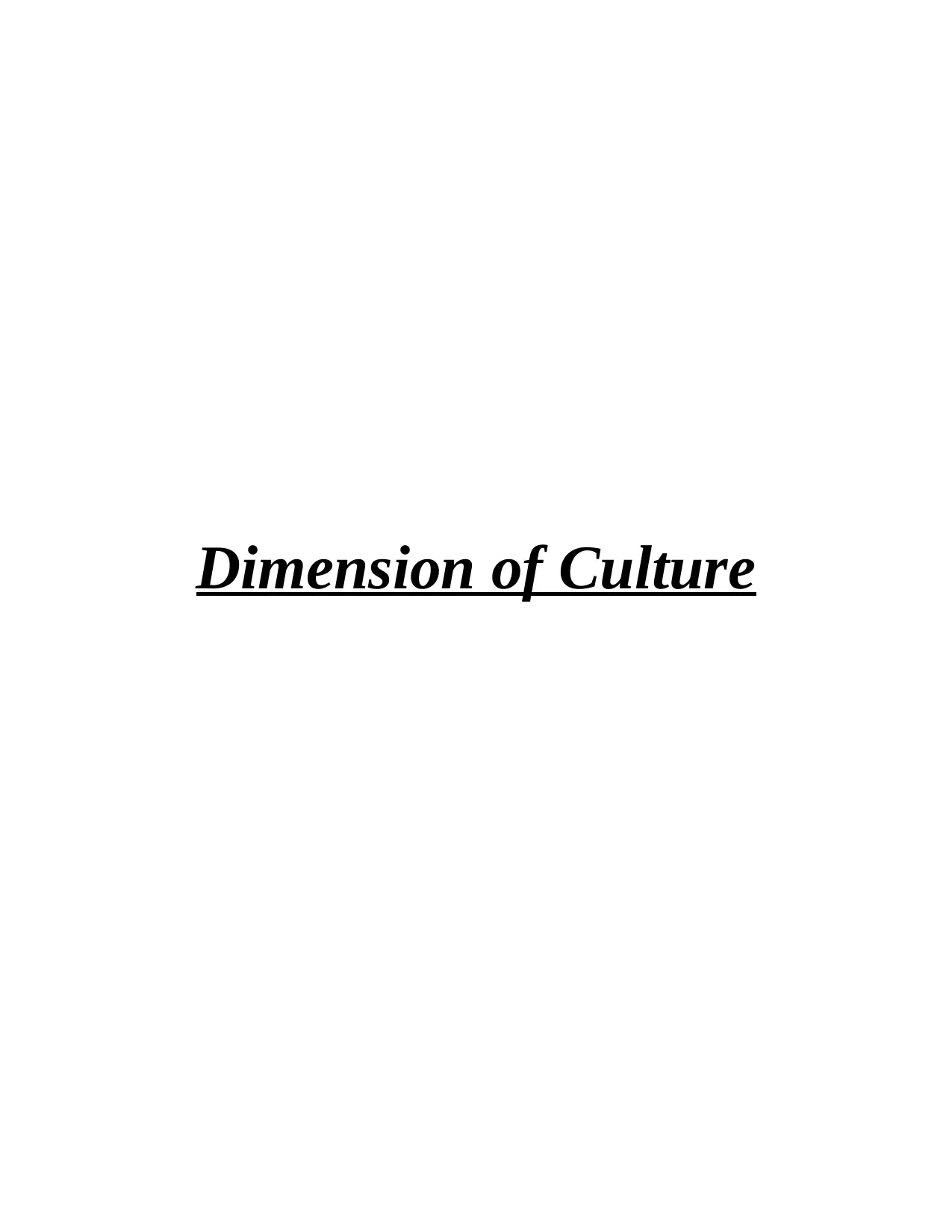
Dimension of Culture
Paraphrase This Document
Need a fresh take? Get an instant paraphrase of this document with our AI Paraphraser
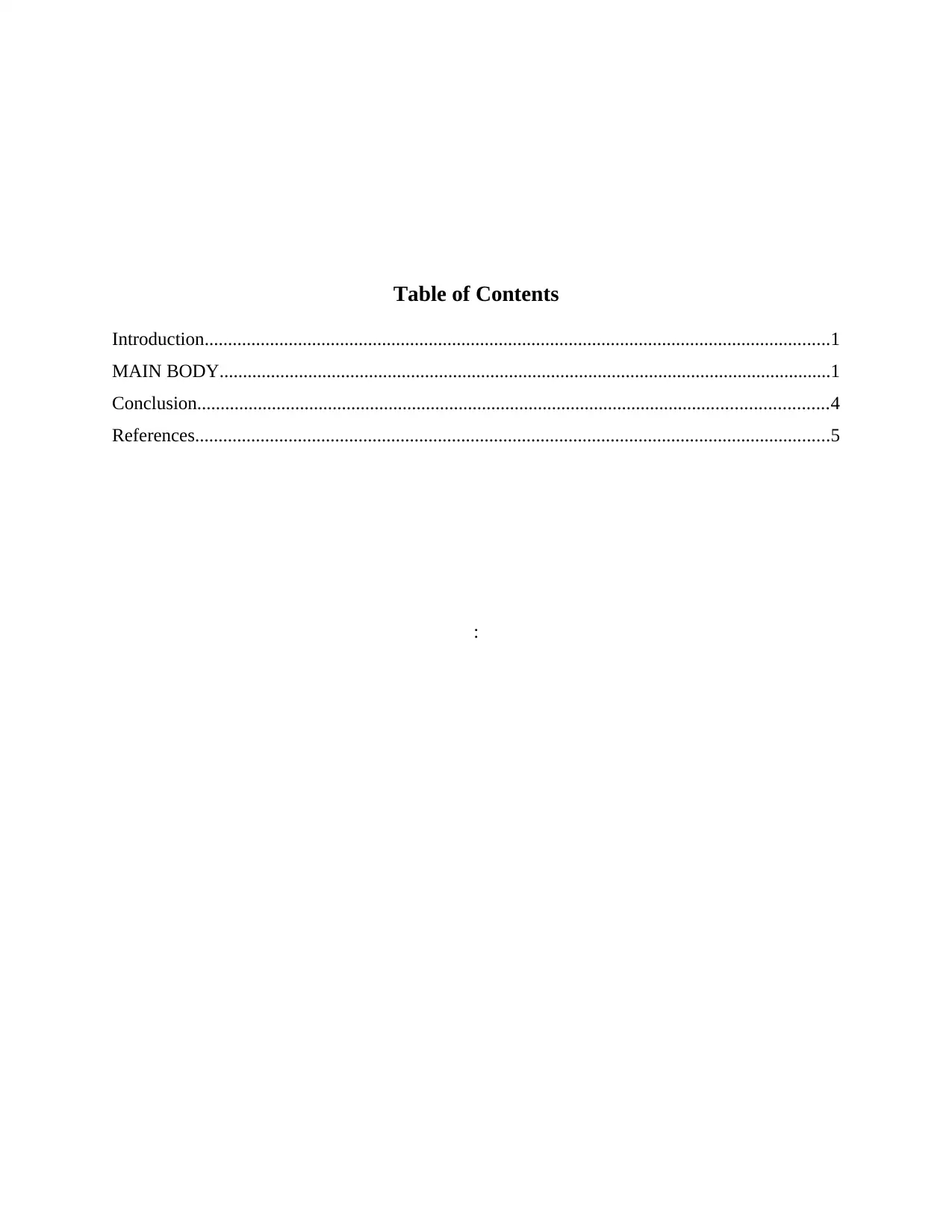
Table of Contents
Introduction......................................................................................................................................1
MAIN BODY...................................................................................................................................1
Conclusion.......................................................................................................................................4
References........................................................................................................................................5
:
Introduction......................................................................................................................................1
MAIN BODY...................................................................................................................................1
Conclusion.......................................................................................................................................4
References........................................................................................................................................5
:
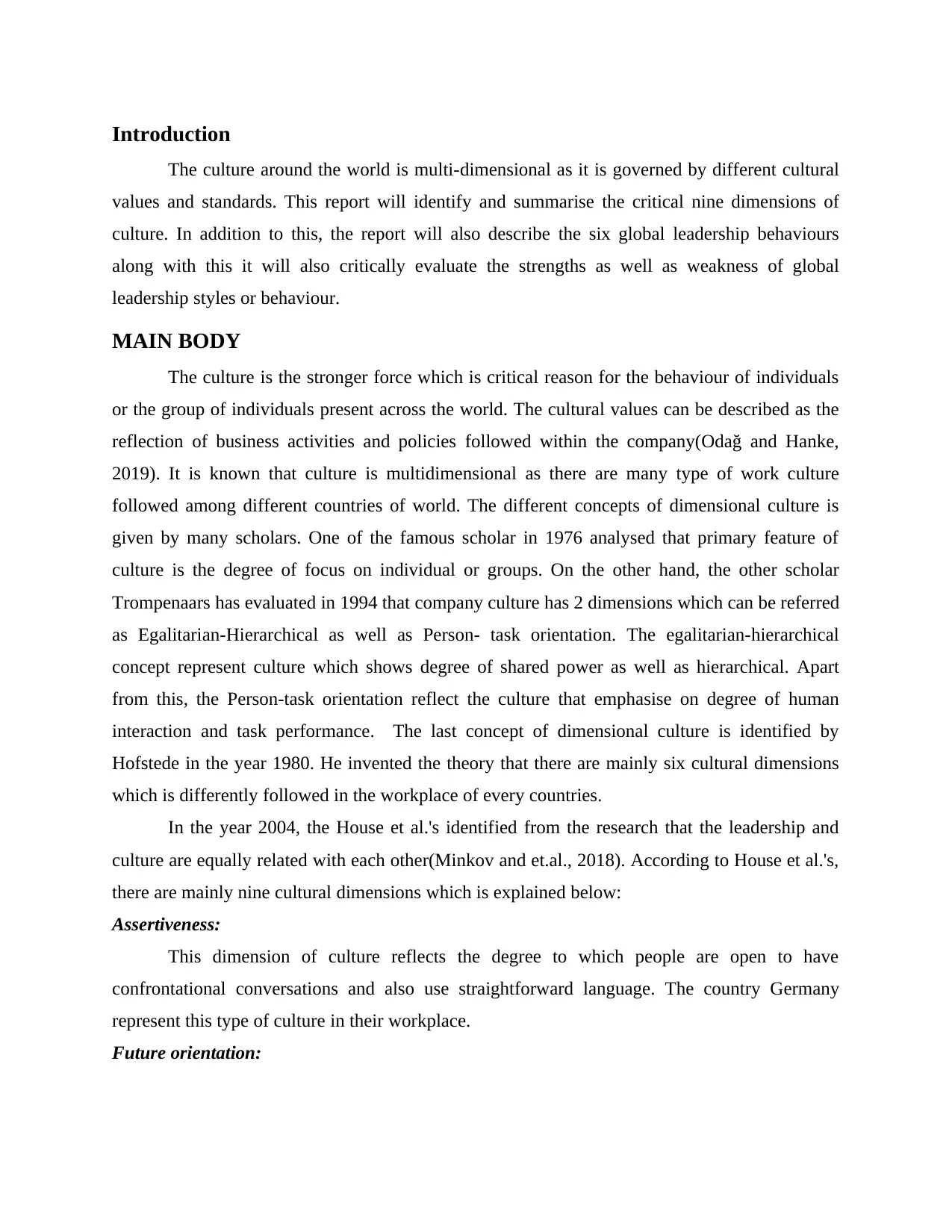
Introduction
The culture around the world is multi-dimensional as it is governed by different cultural
values and standards. This report will identify and summarise the critical nine dimensions of
culture. In addition to this, the report will also describe the six global leadership behaviours
along with this it will also critically evaluate the strengths as well as weakness of global
leadership styles or behaviour.
MAIN BODY
The culture is the stronger force which is critical reason for the behaviour of individuals
or the group of individuals present across the world. The cultural values can be described as the
reflection of business activities and policies followed within the company(Odağ and Hanke,
2019). It is known that culture is multidimensional as there are many type of work culture
followed among different countries of world. The different concepts of dimensional culture is
given by many scholars. One of the famous scholar in 1976 analysed that primary feature of
culture is the degree of focus on individual or groups. On the other hand, the other scholar
Trompenaars has evaluated in 1994 that company culture has 2 dimensions which can be referred
as Egalitarian-Hierarchical as well as Person- task orientation. The egalitarian-hierarchical
concept represent culture which shows degree of shared power as well as hierarchical. Apart
from this, the Person-task orientation reflect the culture that emphasise on degree of human
interaction and task performance. The last concept of dimensional culture is identified by
Hofstede in the year 1980. He invented the theory that there are mainly six cultural dimensions
which is differently followed in the workplace of every countries.
In the year 2004, the House et al.'s identified from the research that the leadership and
culture are equally related with each other(Minkov and et.al., 2018). According to House et al.'s,
there are mainly nine cultural dimensions which is explained below:
Assertiveness:
This dimension of culture reflects the degree to which people are open to have
confrontational conversations and also use straightforward language. The country Germany
represent this type of culture in their workplace.
Future orientation:
The culture around the world is multi-dimensional as it is governed by different cultural
values and standards. This report will identify and summarise the critical nine dimensions of
culture. In addition to this, the report will also describe the six global leadership behaviours
along with this it will also critically evaluate the strengths as well as weakness of global
leadership styles or behaviour.
MAIN BODY
The culture is the stronger force which is critical reason for the behaviour of individuals
or the group of individuals present across the world. The cultural values can be described as the
reflection of business activities and policies followed within the company(Odağ and Hanke,
2019). It is known that culture is multidimensional as there are many type of work culture
followed among different countries of world. The different concepts of dimensional culture is
given by many scholars. One of the famous scholar in 1976 analysed that primary feature of
culture is the degree of focus on individual or groups. On the other hand, the other scholar
Trompenaars has evaluated in 1994 that company culture has 2 dimensions which can be referred
as Egalitarian-Hierarchical as well as Person- task orientation. The egalitarian-hierarchical
concept represent culture which shows degree of shared power as well as hierarchical. Apart
from this, the Person-task orientation reflect the culture that emphasise on degree of human
interaction and task performance. The last concept of dimensional culture is identified by
Hofstede in the year 1980. He invented the theory that there are mainly six cultural dimensions
which is differently followed in the workplace of every countries.
In the year 2004, the House et al.'s identified from the research that the leadership and
culture are equally related with each other(Minkov and et.al., 2018). According to House et al.'s,
there are mainly nine cultural dimensions which is explained below:
Assertiveness:
This dimension of culture reflects the degree to which people are open to have
confrontational conversations and also use straightforward language. The country Germany
represent this type of culture in their workplace.
Future orientation:
⊘ This is a preview!⊘
Do you want full access?
Subscribe today to unlock all pages.

Trusted by 1+ million students worldwide
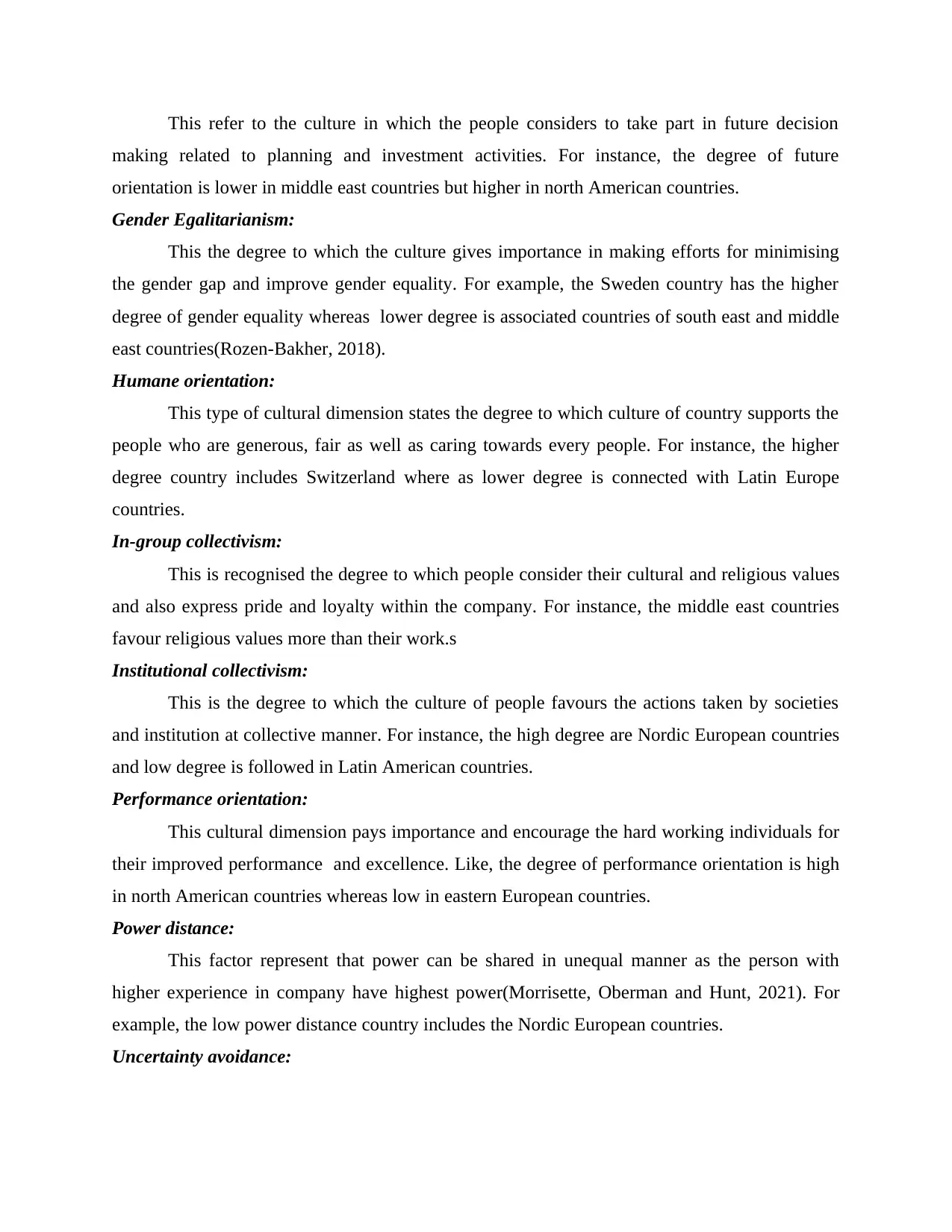
This refer to the culture in which the people considers to take part in future decision
making related to planning and investment activities. For instance, the degree of future
orientation is lower in middle east countries but higher in north American countries.
Gender Egalitarianism:
This the degree to which the culture gives importance in making efforts for minimising
the gender gap and improve gender equality. For example, the Sweden country has the higher
degree of gender equality whereas lower degree is associated countries of south east and middle
east countries(Rozen-Bakher, 2018).
Humane orientation:
This type of cultural dimension states the degree to which culture of country supports the
people who are generous, fair as well as caring towards every people. For instance, the higher
degree country includes Switzerland where as lower degree is connected with Latin Europe
countries.
In-group collectivism:
This is recognised the degree to which people consider their cultural and religious values
and also express pride and loyalty within the company. For instance, the middle east countries
favour religious values more than their work.s
Institutional collectivism:
This is the degree to which the culture of people favours the actions taken by societies
and institution at collective manner. For instance, the high degree are Nordic European countries
and low degree is followed in Latin American countries.
Performance orientation:
This cultural dimension pays importance and encourage the hard working individuals for
their improved performance and excellence. Like, the degree of performance orientation is high
in north American countries whereas low in eastern European countries.
Power distance:
This factor represent that power can be shared in unequal manner as the person with
higher experience in company have highest power(Morrisette, Oberman and Hunt, 2021). For
example, the low power distance country includes the Nordic European countries.
Uncertainty avoidance:
making related to planning and investment activities. For instance, the degree of future
orientation is lower in middle east countries but higher in north American countries.
Gender Egalitarianism:
This the degree to which the culture gives importance in making efforts for minimising
the gender gap and improve gender equality. For example, the Sweden country has the higher
degree of gender equality whereas lower degree is associated countries of south east and middle
east countries(Rozen-Bakher, 2018).
Humane orientation:
This type of cultural dimension states the degree to which culture of country supports the
people who are generous, fair as well as caring towards every people. For instance, the higher
degree country includes Switzerland where as lower degree is connected with Latin Europe
countries.
In-group collectivism:
This is recognised the degree to which people consider their cultural and religious values
and also express pride and loyalty within the company. For instance, the middle east countries
favour religious values more than their work.s
Institutional collectivism:
This is the degree to which the culture of people favours the actions taken by societies
and institution at collective manner. For instance, the high degree are Nordic European countries
and low degree is followed in Latin American countries.
Performance orientation:
This cultural dimension pays importance and encourage the hard working individuals for
their improved performance and excellence. Like, the degree of performance orientation is high
in north American countries whereas low in eastern European countries.
Power distance:
This factor represent that power can be shared in unequal manner as the person with
higher experience in company have highest power(Morrisette, Oberman and Hunt, 2021). For
example, the low power distance country includes the Nordic European countries.
Uncertainty avoidance:
Paraphrase This Document
Need a fresh take? Get an instant paraphrase of this document with our AI Paraphraser
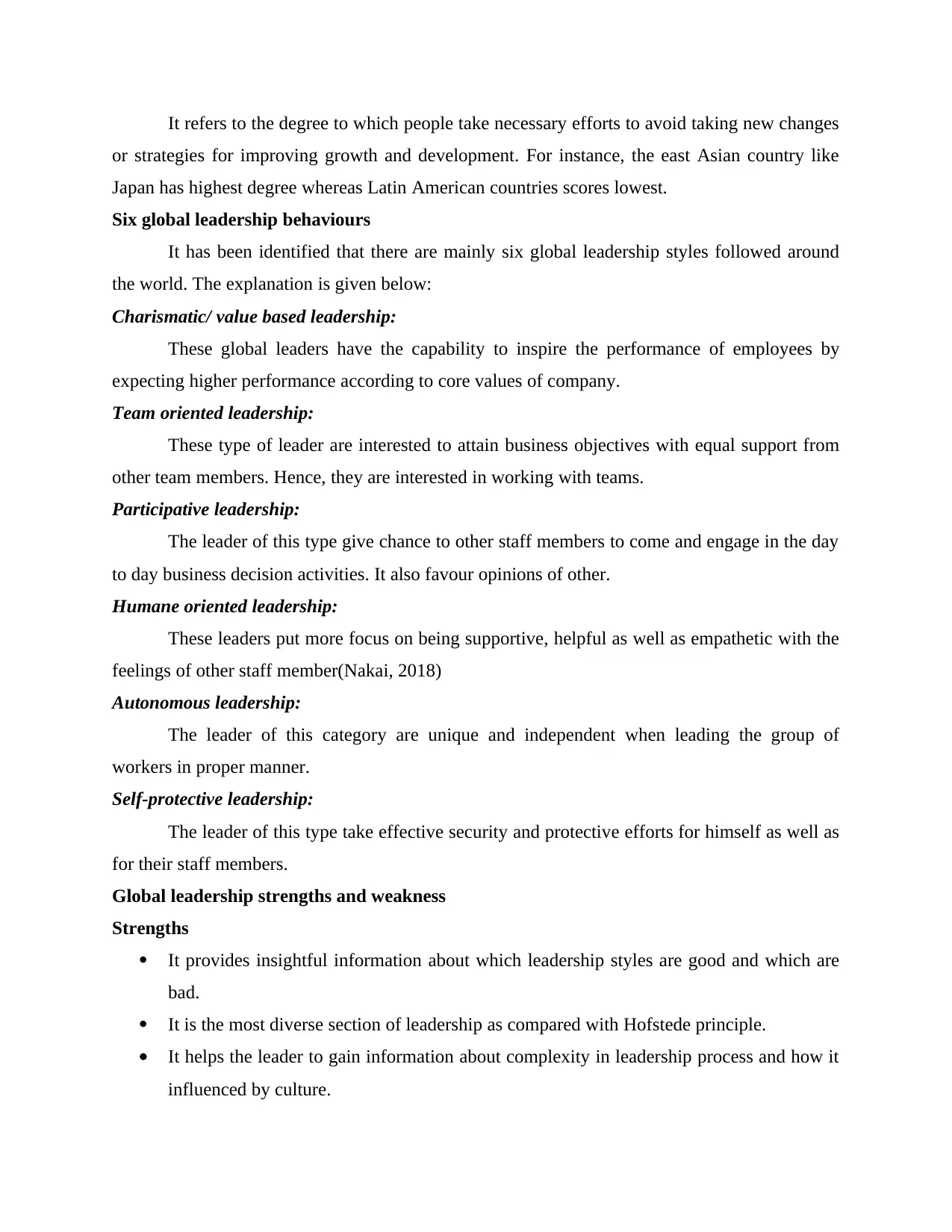
It refers to the degree to which people take necessary efforts to avoid taking new changes
or strategies for improving growth and development. For instance, the east Asian country like
Japan has highest degree whereas Latin American countries scores lowest.
Six global leadership behaviours
It has been identified that there are mainly six global leadership styles followed around
the world. The explanation is given below:
Charismatic/ value based leadership:
These global leaders have the capability to inspire the performance of employees by
expecting higher performance according to core values of company.
Team oriented leadership:
These type of leader are interested to attain business objectives with equal support from
other team members. Hence, they are interested in working with teams.
Participative leadership:
The leader of this type give chance to other staff members to come and engage in the day
to day business decision activities. It also favour opinions of other.
Humane oriented leadership:
These leaders put more focus on being supportive, helpful as well as empathetic with the
feelings of other staff member(Nakai, 2018)
Autonomous leadership:
The leader of this category are unique and independent when leading the group of
workers in proper manner.
Self-protective leadership:
The leader of this type take effective security and protective efforts for himself as well as
for their staff members.
Global leadership strengths and weakness
Strengths
It provides insightful information about which leadership styles are good and which are
bad.
It is the most diverse section of leadership as compared with Hofstede principle.
It helps the leader to gain information about complexity in leadership process and how it
influenced by culture.
or strategies for improving growth and development. For instance, the east Asian country like
Japan has highest degree whereas Latin American countries scores lowest.
Six global leadership behaviours
It has been identified that there are mainly six global leadership styles followed around
the world. The explanation is given below:
Charismatic/ value based leadership:
These global leaders have the capability to inspire the performance of employees by
expecting higher performance according to core values of company.
Team oriented leadership:
These type of leader are interested to attain business objectives with equal support from
other team members. Hence, they are interested in working with teams.
Participative leadership:
The leader of this type give chance to other staff members to come and engage in the day
to day business decision activities. It also favour opinions of other.
Humane oriented leadership:
These leaders put more focus on being supportive, helpful as well as empathetic with the
feelings of other staff member(Nakai, 2018)
Autonomous leadership:
The leader of this category are unique and independent when leading the group of
workers in proper manner.
Self-protective leadership:
The leader of this type take effective security and protective efforts for himself as well as
for their staff members.
Global leadership strengths and weakness
Strengths
It provides insightful information about which leadership styles are good and which are
bad.
It is the most diverse section of leadership as compared with Hofstede principle.
It helps the leader to gain information about complexity in leadership process and how it
influenced by culture.
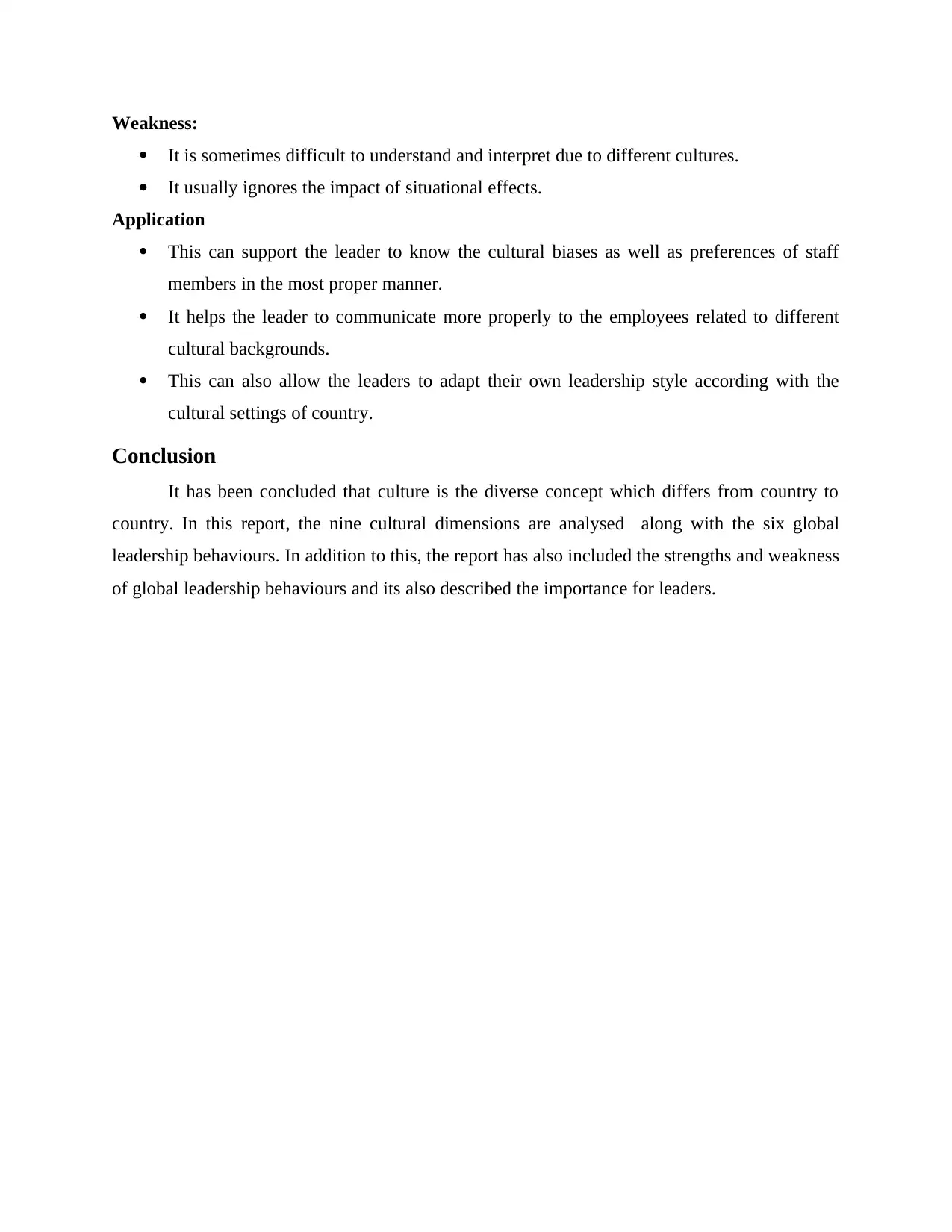
Weakness:
It is sometimes difficult to understand and interpret due to different cultures.
It usually ignores the impact of situational effects.
Application
This can support the leader to know the cultural biases as well as preferences of staff
members in the most proper manner.
It helps the leader to communicate more properly to the employees related to different
cultural backgrounds.
This can also allow the leaders to adapt their own leadership style according with the
cultural settings of country.
Conclusion
It has been concluded that culture is the diverse concept which differs from country to
country. In this report, the nine cultural dimensions are analysed along with the six global
leadership behaviours. In addition to this, the report has also included the strengths and weakness
of global leadership behaviours and its also described the importance for leaders.
It is sometimes difficult to understand and interpret due to different cultures.
It usually ignores the impact of situational effects.
Application
This can support the leader to know the cultural biases as well as preferences of staff
members in the most proper manner.
It helps the leader to communicate more properly to the employees related to different
cultural backgrounds.
This can also allow the leaders to adapt their own leadership style according with the
cultural settings of country.
Conclusion
It has been concluded that culture is the diverse concept which differs from country to
country. In this report, the nine cultural dimensions are analysed along with the six global
leadership behaviours. In addition to this, the report has also included the strengths and weakness
of global leadership behaviours and its also described the importance for leaders.
⊘ This is a preview!⊘
Do you want full access?
Subscribe today to unlock all pages.

Trusted by 1+ million students worldwide
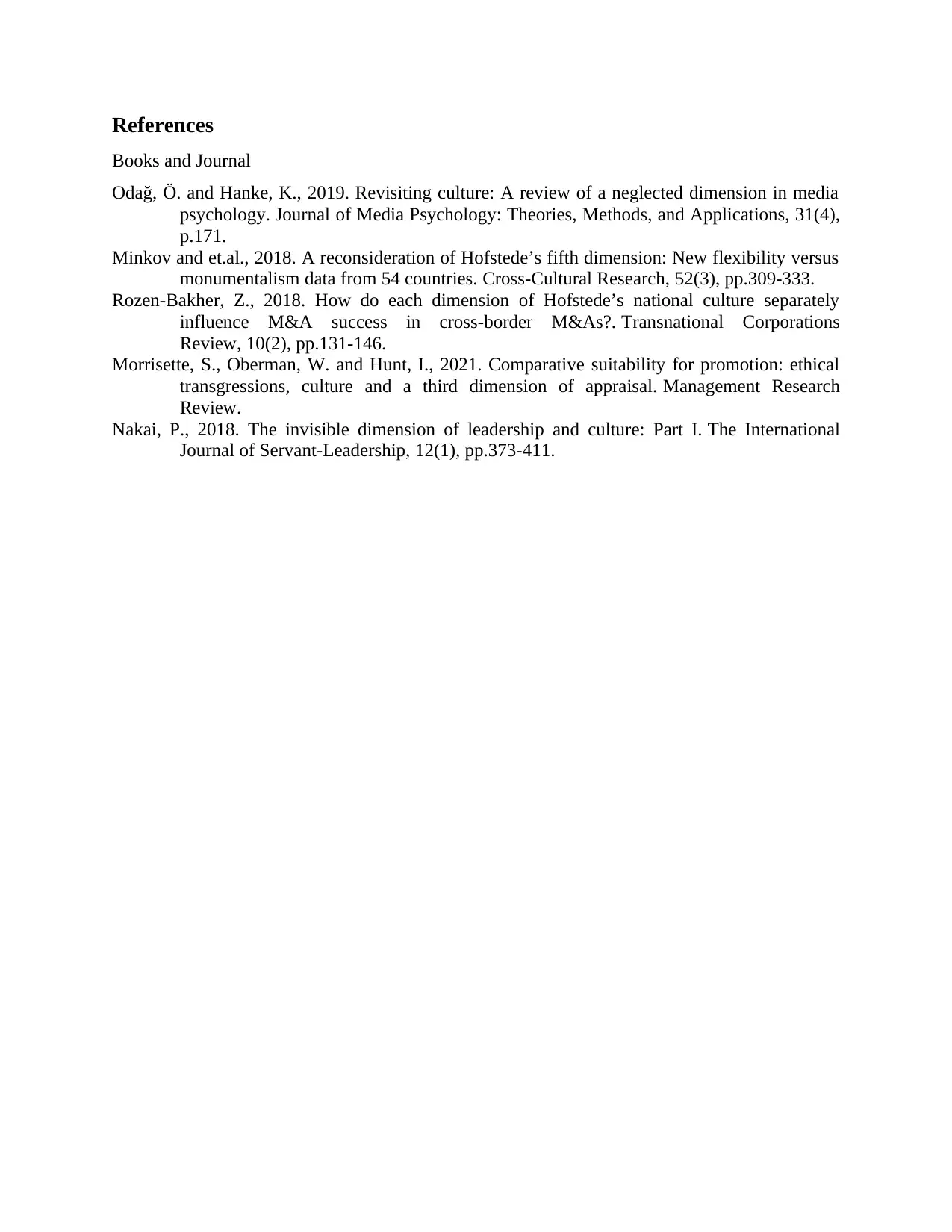
References
Books and Journal
Odağ, Ö. and Hanke, K., 2019. Revisiting culture: A review of a neglected dimension in media
psychology. Journal of Media Psychology: Theories, Methods, and Applications, 31(4),
p.171.
Minkov and et.al., 2018. A reconsideration of Hofstede’s fifth dimension: New flexibility versus
monumentalism data from 54 countries. Cross-Cultural Research, 52(3), pp.309-333.
Rozen-Bakher, Z., 2018. How do each dimension of Hofstede’s national culture separately
influence M&A success in cross-border M&As?. Transnational Corporations
Review, 10(2), pp.131-146.
Morrisette, S., Oberman, W. and Hunt, I., 2021. Comparative suitability for promotion: ethical
transgressions, culture and a third dimension of appraisal. Management Research
Review.
Nakai, P., 2018. The invisible dimension of leadership and culture: Part I. The International
Journal of Servant-Leadership, 12(1), pp.373-411.
Books and Journal
Odağ, Ö. and Hanke, K., 2019. Revisiting culture: A review of a neglected dimension in media
psychology. Journal of Media Psychology: Theories, Methods, and Applications, 31(4),
p.171.
Minkov and et.al., 2018. A reconsideration of Hofstede’s fifth dimension: New flexibility versus
monumentalism data from 54 countries. Cross-Cultural Research, 52(3), pp.309-333.
Rozen-Bakher, Z., 2018. How do each dimension of Hofstede’s national culture separately
influence M&A success in cross-border M&As?. Transnational Corporations
Review, 10(2), pp.131-146.
Morrisette, S., Oberman, W. and Hunt, I., 2021. Comparative suitability for promotion: ethical
transgressions, culture and a third dimension of appraisal. Management Research
Review.
Nakai, P., 2018. The invisible dimension of leadership and culture: Part I. The International
Journal of Servant-Leadership, 12(1), pp.373-411.
Paraphrase This Document
Need a fresh take? Get an instant paraphrase of this document with our AI Paraphraser


⊘ This is a preview!⊘
Do you want full access?
Subscribe today to unlock all pages.

Trusted by 1+ million students worldwide

Paraphrase This Document
Need a fresh take? Get an instant paraphrase of this document with our AI Paraphraser

1 out of 11
Related Documents
Your All-in-One AI-Powered Toolkit for Academic Success.
+13062052269
info@desklib.com
Available 24*7 on WhatsApp / Email
![[object Object]](/_next/static/media/star-bottom.7253800d.svg)
Unlock your academic potential
Copyright © 2020–2025 A2Z Services. All Rights Reserved. Developed and managed by ZUCOL.





